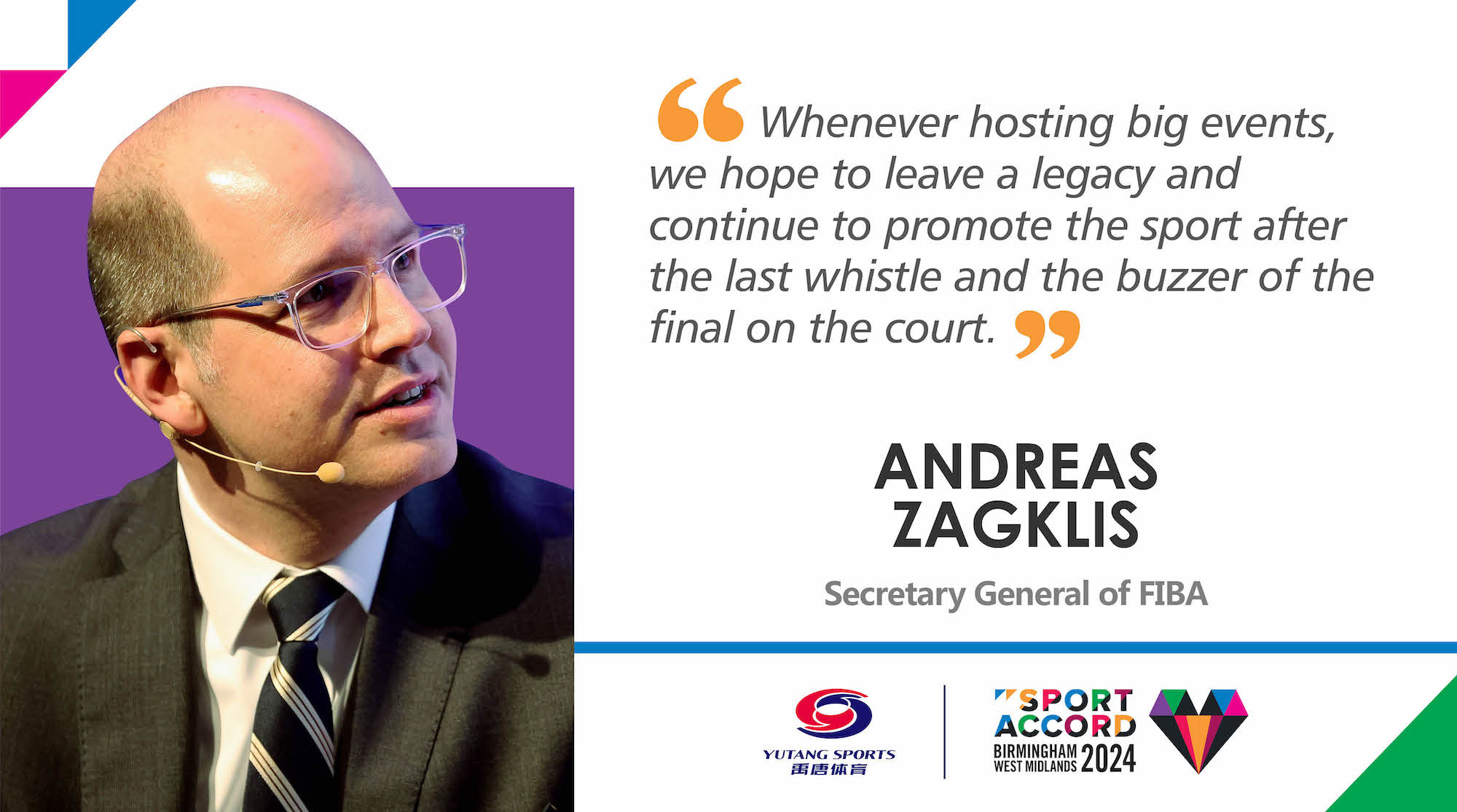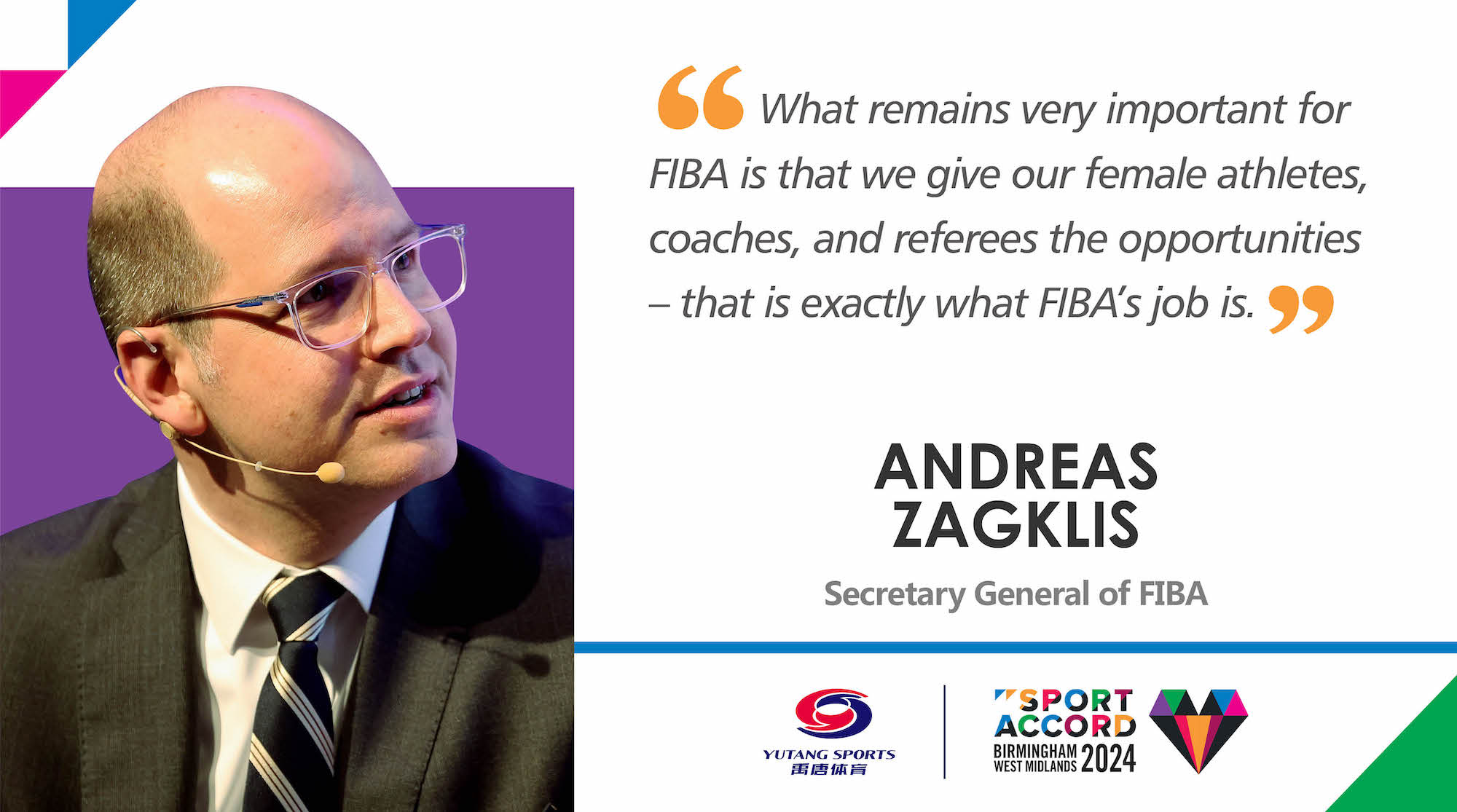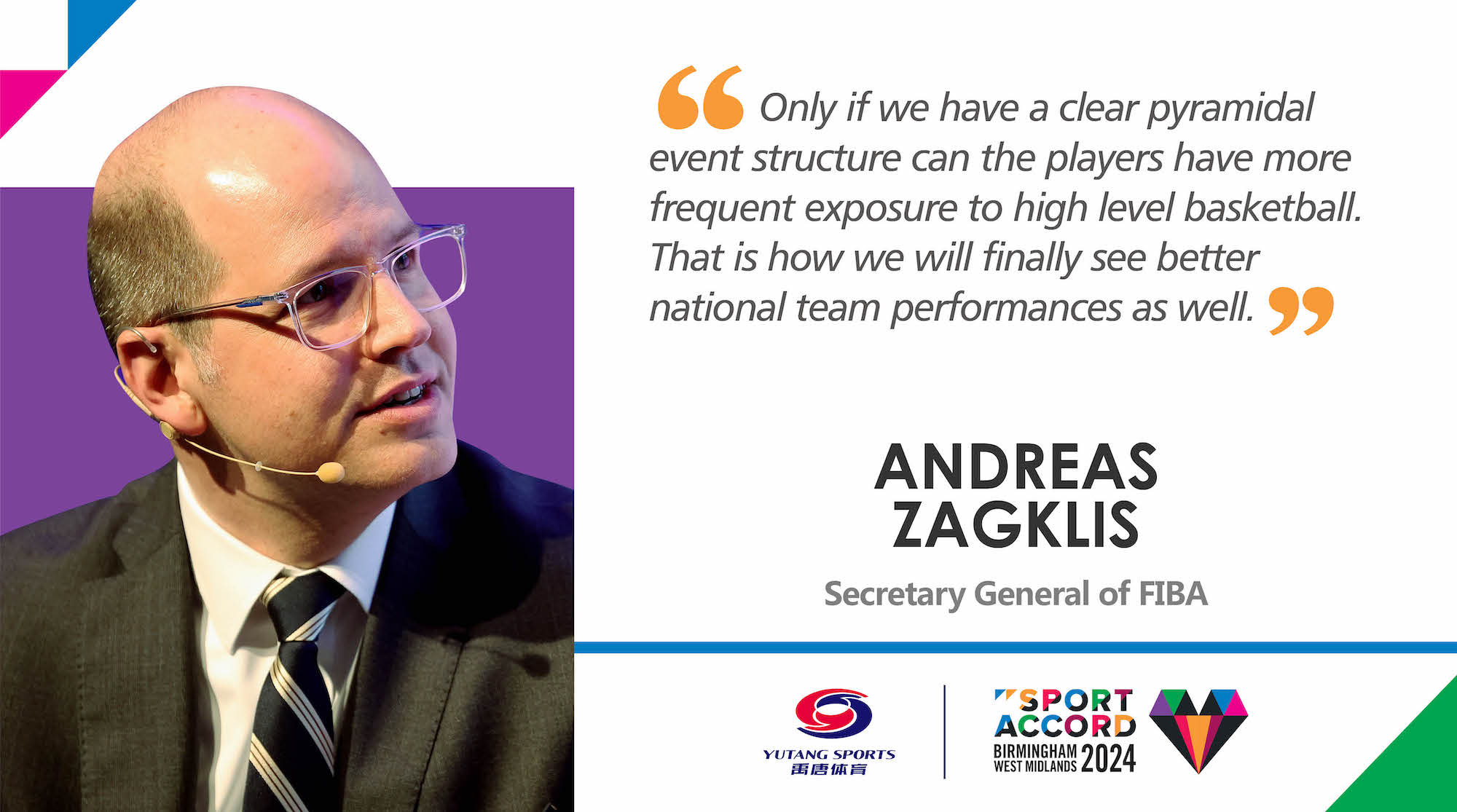From April 7 to 11, the SportAccord World Sport & Business Summit, returned in Birmingham, West Midlands and brought together around 1,700 sporting leaders and key decision makers from over 120 International Federations, the International Olympic Committee, and organizations involved in the business of sport.
Themed at “The Power of Sport”, the Sport’s most influential gathering delivered a week-long combination of official sports meetings, social gatherings, a themed conference programme and exhibition space for International Federations, industry, cities and regions to focus on the challenges and opportunities ahead for global sports community.
As one of the summit’s principal media partners, Yutang Sports were honored to have an in-depth conversation with Andreas Zagklis, Secretary General of FIBA, who shared his thoughts on FIBA's strategic planning, development goals, as well as insights on Chinese market.
Andreas Zagklis ©️Yutang Sports
Positive impact under the eight-year strategy
Lead by Zagklis, the strategic roadmap of FIBA for the 2019-2027 cycle was approved by the organization and has been implemented with full pace. In Zagklis' point of view, the eight-year strategy is existing as a continuation of the new era of FIBA that started in 2014, and has lead the organization to deliver an entirely different level of the World Cup event in 2019 in China, followed by a record-breaking edition in Philippine, Japan and Indonesia in 2023.
Noticeable impacts can also be seen in women basketball territory boosted by the new strategy. “The 2022 FIBA Women’s Basketball World Cup in Australia has put a lot of responsibility on us and on our next hosts, Berlin, Germany, for the year 2026,” says Zagklis, “And I also believe that the positive impact of the strategy was seen in Tokyo Olympic Games, where, at every step of men’s podium and women’s podium, we had medalist teams representing three totally different continents.”
3x3 basketball and Chinese market – in rapid development
Along with the rise of new generations, the 3x3 basketball has been existing as a significant part in FIBA’s long-term strategy. When talking about the organization’s effort and achievements on 3x3 basketball promotions, Zagklis believes that it has by far become one of the most popular urban sports disciplines. Championed by the young, the 3x3 basketball achieved its first goal in 2017 – to be an Olympic sport discipline, which was a big part of the legacy left by Zagklis’ predecessor, Patrick Baumann, while the current objective is to bring the discipline to the next level.
“We have already arrived at the next level in 2023, when 3x3 basketball surpassed 1 billion views on social media, which, if counting 3x3 basketball’s social media as a standalone international federation account, would be among the seven biggest viewership of all Olympics sports federations.
“For me, what is especially important is that countries of all size see the opportunities emerging from 3x3 basketball. A clear example is in east Asia, where, from Mongolia, with a few million population to China, you could see how popularity effect of 3x3 basketball is utilized to bring basketball to schools and to the center of the city.”
Eyes on the upcoming Paris Olympic Games, in which both China men’s and women’s national 3x3 basketball teams have secured their tickets to the iconic La Concorde Urban Park, further development of this sport in China, built on the Olympics momentum, is foreseeable. According to Zagklis, the current achievement is inextricably associated with China’s systematic and well-prepared approach.
“I think the ‘moment’ was not China’s qualifications to Paris but a medal in Tokyo, historically acclaimed by women’s national 3x3 basketball team, which has changed everything. I still remember that day we were with Yao Ming, President of China Basketball Association (CBA), in the venue of Tokyo Olympics, where I understood what that medal meant for CBA and for Chinese Olympic Committee. The next steps of the preparation and the qualifications to Paris was a very good continuation. I'm glad that after COVID, FIBA has been back to China with more events in a large number of cities around the country.”
The organization’s blueprint in Chinese market can be explicitly traced following FIBA’s promotion of 3x3 basketball. There is no doubt that the Chinese market has always been important to FIBA, based on which Zagklis is paying more attention to the long-term effects of hosting major events. Beyond the competitions themselves, he hopes to leave a legacy and continue to promote the sport after the last whistle and the buzzer of the final on the court.
“We have an office in Beijing and a smaller branch in Guangzhou,” Zagklis tells Yutang Sports, “The FIBA China office works very closely with the CBA and is dedicated to the development of youth training and complementing CBA’s work. Since there is such a desire for high level basketball training in China, FIBA is now fulfilling its duty to provide high quality programs to millions of fans and young people.”
Following the organization’s roadmap in China, Zagklis highly praises the business development of the office, where nine of its ten employees are Chinese professionals who frequently come to FIBA’s headquarter in Geneva and have constant communications.
To keep enhancing digitalization and maximizing the value of women events
Supported by innovative technologies, digitalization has become a major trend throughout the entire sports community, while FIBA has also put extensive efforts in this regard, with young generations being one of the organization’s top targets. In that sense, Zagklis believes that having two Olympic disciplines, the traditional basketball discipline and a more urban-friendly 3x3 discipline, creates a fantastic combination for FIBA to keep targeting new audiences, especially considering the fact that the majority of the 3x3 basketball fans do not follow the FIBA’s traditional social media channels.
Another essential element could be FIBA’s audacious and open approaches in videos and images sharing on its social media. “We have taken, in this regard, a risk that is now paying off,” attaches Zagklis, “FIBA’s Over The Top offering, Court side1891, in partnership with DAZN, is at the heart of our strategy and enables fans to watch their favorite FIBA games wherever they are in the world.”
“That was another crucial step, big and not simple, in our commercial strategy roadmap. Therefore, I think that a combination of a very modern approach to social media and online offerings of all our games to fans, along with two sport disciplines that can attract fans at all ages, give us this all-round digitalization strategy.”
In addition to digitalization, it is women sports that remains as another hot and valuable topic not only in basketball territory but in the world of sports, especially under the current frenzy in women basketball events at US college and professional levels, led by superstars. Zagklis also goes straightforwardly that “women in basketball” is one of FIBA’s three strategic priorities. And to achieve that, higher visibility of women's events is necessary.
“The superstars could be one fundamental element of this recipe. And having now superstar college athletes going into professional women's basketball is important,” says Zagklis, “While at the same time, we should not forget that the women's World Cup has already witnessed the rising superstars, from Han Xu to Breanna Stewart, Emma Meesseman, and Sabrina Ionescu. They are all players that make a team sport and the event of a team sport filled with very high quality and value. What remains very important for FIBA is that we give our female athletes, coaches, and referees the opportunities – that is exactly what FIBA’s job is.”
When given such opportunities, women players could really attract public attentions and commercial interests in a more positive pace, bringing the sport to a higher level. “I'm glad that we have superstars, but I am more concerned about the overall product of women basketball and a higher average attention, not only to one college game or one World Cup finals,” attaches Zagklis, “That is why I will go directly from SportAccord in Birmingham (April 10th) to the final of the FIBA EuroLeague Women in Turkey, where we'll have some fantastic club basketball games.”
A pyramidal event structure is underway
Built on the solid foundation set by National Leagues, basketball in East Asia has been entering a golden era with evident and rapid growth.
Zagklis also acknowledges that the CBA league in China has strongly bounced back after the post-pandemic era, with the competitive level going up every year. In the meantime, professional leagues in Japan and Korea are solid as well, while Philippines’s league is now becoming more open, with increasing domestic players going abroad and Asian players coming in a more active manner, which is part of the legacy left by the FIBA 2023 World Cup. After Philippines follows Indonesia, as well as some other markets, where FIBA is planning to introduce its events soon.
The organization has a clear objective to build a clean network of competitions. At the top lies the FIBA Intercontinental Cup in Singapore that brings together top clubs around the world, followed by FIBA Basketball Championships Leagues in Europe and America. While in Asia, the former FIBA Asia Champions Cup was also renamed to the Basketball Champions League Asia. The West Asia Super League and the East Asia Super League complete the lineup of international leagues in Asia.
In a nutshell, FIBA has been building a clear pyramidal event structure for the world of basketball. “Only if we have a clear pyramidal structure, where teams in National Leagues are able to qualify to international stages and to play more international games, can the players have more frequent exposure to high level basketball that they need. And that is how we will finally see better national team performances as well. I'm convinced about that.”
About SportAccord World Sport & Business Summit
The SportAccord World Sport & Business Summit brings together around 1,500 leaders and key decision makers from over 120 International Federations (IFs), the International Olympic Committee, and organisations involved in the business of sport.
The Summit provides an unrivalled platform enabling global business leaders and host cities to have access to all the International Federations and their stakeholders in one location over several days.
This unique event is a combination of official sports meetings, networking gatherings, a themed conference programme, and exhibition space enabling International Federations, industry, cities and regions to showcase and advance their sport, services and facilities.
About SPORTACCORD
SportAccord is a sports event organisation based in the Olympic Capital, Lausanne, Switzerland, and governed by stakeholders representing the Olympic and non-Olympic International Federations.
It brings together International Federations and organisations involved in the business of sport with the aim to serve, promote and protect the common interests of its stakeholders, help them achieve their global objectives and facilitate knowledge-sharing.
SportAccord’s stakeholders include:
ASOIF (Association of Summer Olympic International Federations)
WOF (Winter Olympic Federations)
ARISF (Association of IOC Recognised International Sports Federations)
AIMS (Alliance of Independent Recognised Members of Sport)
Visit SportAccord.sport for more information.
About Yutang Sports
As one of SportAccord's Principal Media Partners, Yutang Sports is a Chinese leading sports marketing and media platform, with an ultimate mission to connect China and world through sports. After years of growing, Yutang Sports, with a comprehensive media and marketing promotion system, is now dedicating to reporting sports business and marketing trends, providing sports business news, analysis, and exclusive data reports in both Chinese and English. Having been cooperated with top-level domestic and international sports summits, Yutang Sports is opening a window for Chinese sports industry to embrace the world.








